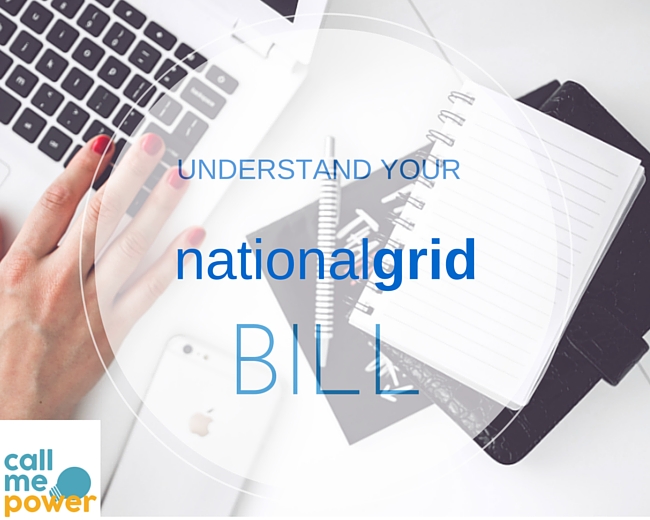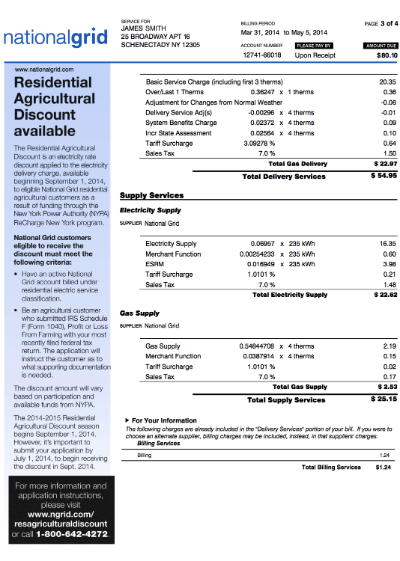Understanding Your National Grid Bill in New York State

National Grid has a specific bill format that is different from other utilities. Here we explain what a typical National Grid bill looks like, and how your can save money on your energy bills.
Want to Save Money on Your National Grid Bill?
Electricity prices are rising each year, so here are a few ideas for taking the pressure off your energy budget.
The most effective change you can make is to reduce your overall energy consumption. A lot of the items on your National Grid bill are charged on a per kWh basis, so improving your energy efficiency at home can go a long way towards lowering your bills.
Energy Saving Ideas Check out some of our useful tips about how to save money on your energy bills, including how to save money in the summer, how to use your appliances wisely, and all about a little thing called vampire energy
Another option you can take is to take a look at the rate you're paying with National Grid, and see if it can be beat by an alternate energy supply company (ESCO). With electricity markets in New York open to competition, many alternative suppliers can offer competitive rates for electricity and natural gas.
To learn more about energy supply options in your area, check out our pages on energy in New York, or call us directly at phone currently not available to find the best rates in your area.
Example of a 2014 National Grid Bill - Page 1: Summary
Account Information:
This section includes your account number, customer address, billing period, and the amount due. It is important to verify that this information is correct on each bill that you receive, so that you know that you are being billed accurately.
Account Balance
- Previous balance: Charges from previous bills (here a bill from May 5th, 2014).
- Payment received: Payment last received by National Grid for the payment of the previous bill. If the bill has been paid in full, this will be equal to the previous balance.
- Current charges: These are the charges for the current bill.
- Amount due: This will be equal to the current charges if the previous bill has been paid in full.
- "Do not pay": Depending on your payment method, a different message can appear here describing your next actions for bill payment.
- Message center: Since the customer did not pay his/her bill the previous month (the $207.86 outstanding balance for previous charges), an "adjustment" charge of $3.12 (1.5% of $207.86) has been added to the current bill.
Summary of Current Charges
Towards the middle of the first page you will find a summary of your charges due for the month, broken down into charges for electricity and gas supply and delivery. Remember, while you can't do much about your delivery charges, you can take control of how much you pay for your energy supply by comparing your current supply charges with what's on offer with alternate Energy Supply Companies (ESCOs). ESCOs in New York offer a wide variety of price options, and many can offer great deals compared to what you currently pay with National Grid.
Payment Stub
At the bottom of your bill you will find the payment stub. Make sure to mail the payment stub with your check if mailing in a payment. You can also use the payment stub when paying your bill in person
Example of a 2014 National Grid bill - Page 2: Delivery Charges
Left column:
This column indicates your monthly electricity and gas consumption history over the past six months. Knowing how much energy you consume per a month on average will help you estimate how much you pay for electricity per month, and will help you compare rates with alternate suppliers.
Delivery Services:
Electricity delivery
- Meter information: This resumes the meter reading: dates of current and last meter reading and number of days, kWh shown on current and last meter reading and number of kWh.
- Rate: Electric SC1 Non Heat: This describes your rate plan. You can find more information different rate types on Rates & Tariffs for National Grid in New York State, and Service Classification for National Grid in New York State.
- Basic Service: This is a monthly fixed amount no matter how much electricity you consume. It includes the cost for reading and maintaining the meters, billing, equipment and maintenance.
- Delivery: This is the charge to bring the electricity from the electricity production site to your home. This is not a supply cost since it is the same regardless of your supplier.
- Incremental state assessment: Also called the Temporary New York State Surcharge, it is created to encourage the conservation of energy and other resources provided through utility companies.
- SBC (state surcharge): The System Benefits Charge incentivizes energy efficiency initiatives, education and outreach, R&D, and energy assistance for people with low-income.
- RPS (state surcharge): The Renewable Portfolio Standard incentivizes renewable energy goals set by the state of New York.
- Legacy transition charge: Customers are billed the cost or benefit of electricity supply agreements National Grid signed before June 1, 2001. Residential customers also receive the benefit of low cost hydropower and a discount payment from the New York Power Authority.
- RDM: Revenue Decoupling Mechanism: National Grid makes yearly previsions on the revenues associated with the delivery service to customers. If the targets for delivery revenues are reached, then the surplus is refunded to the customer, and if the targets are not reached, the lack is collected from the customers.
- Transmission Revenue Adjustment: This is identical to the RDM, but for the transmission revenues. If the targets for the revenues associated with the transmission of the electricity are reached, the surplus is refunded to the customer, and if not, the lack is collected from the customers.
- Tariff Surcharge: New York State and many local municipalities impose taxes on National Grid's revenue. These costs are recovered through a tariff surcharge and may vary depending on the municipality.
- Sales Tax: In some areas National Grid is required to collect state and local sales taxes for the sales of electricity.
Gas Delivery
- Meter information: This resumes the gas meter reading: dates of current and last meter reading and number of days, volume (in ccf) shown on current and last meter reading, conversion factor between volume (ccf) and energy (therm), and calculated number of therms used.
- Rate: Gas SC1 Residential Heat: Indeed, the electric service is SC1 non heat, since the gas takes care of the heat portion of the home energy needs. You can find more information different rate types on Rates & Tariffs for National Grid in New York State, and Service Classification for National Grid in New York State.
Example of a 2014 National Grid Bill - Page 3: Delivery and Supply Charges
Gas Delivery (continued):
- Basic Service Charge: This is a monthly fixed amount after the first 3 therms you consume. It includes the cost for reading and maintaining the meters, billing, equipment and maintenance.
- Over/Last 1 Therms: This is the Delivery Service Charge for the rest of your gas consumption after the first 3 therms. In this example, the customer has only consumed 4 therms in total, therefore this charge will only count 1 therm.
- Adjustment for Changes from Normal Weather: This is the same as the charge called "Monthly rate adjustment" in other utilities (ConEdison for example). This charge adjusts the customer's gas bills due to variations from normal weather during the cold months (October through May).
- Delivery Service Adjustment(s): This charge is either collected or returned to the customer and includes a Pipeline Refund, Net Revenue Sharing Adjustment, Research & Development Surcharge, Revenue Decoupling Mechanism Adjustment, and Deferral Credit.
- System Benefits Charge: This is a charge pay for certain public policy programs such as energy efficiency.
- Incremental State Assessment Surcharge: (Also called Temporary New York State Surcharge) created to encourage the conservation of energy.
- Tariff Surcharge: charges which pays for State and municipal tax imposed on National Grid's revenue.
- Sales Tax: state and local sales tax for the sales of gas.
Supply Services
Electricity Supply
- Electricity Supply: The market price of electricity supply used during the billing period.
- Merchant Function Charge: A charge for National Grid's costs of procuring gas or electricity supply on your behalf. National Grid will not bill you this charge if you choose an ESCO for your energy supply.
Compare the Electricity Supply charge together with the Merchant Function Charge with what ESCOs offer to find the best deals for your electricity and gas.
Don't have time? Call us at phone currently not available to find the best rates for your home in minutes.
- ESRM: Electricity Supply Reconciliation Mechanism: In winter months colder than the average winter, the market prices of electricity rise due to high demand. The bills for residential customers can see great increase, since both the price of electricity, and the demand in electricity increase. The Public Service Commission of New York State has agreed to allow National Grid to spread out this bill increase. Therefore during a very cold month you will see this ESRM charge as a negative charge, in reality lending you money to avoid paying a high bill during an unusually cold month, and will reimburse this loan by surcharging you during the following months.
- Tariff Surcharge: See definition above.
- Sales Tax: Same as above definition.
Gas Supply
- Gas Supply: This pays for National Grid to purchase the gas from suppliers, and also to transport the gas to National Grid's distribution system. If you choose ESCO for your natural gas supply, the price will be what you have agreed upon with that supplier.
- Merchant Function: See definition above.
- Tariff Surcharge: See definition above.
- Sales Tax: See definition above.
For Your Information
- Billing Services: these are the charges to create and send your bill, as well as process your payment. They are already included in the delivery portion of your bill, but are here for your information. If you choose an ESCO, it may in some cases pay for the billing services, in which case it would be included in the supplier's charges of the alternate supplier.
Example of a 2014 National Grid Bill - page 4: Lexicon
Definitions:
This pages provides you with definitions of each section of your bill, as well as reminders of how to pay your National Grid bill.
Want to Save Money on Your National Grid Bill?See if the rate you currently pay for electricity or natural gas with National Grid can't be beat by an ESCO - call us at phone currently not available



